I have some exciting news for those who enjoy lambic and geuze/gueuze, Belgium’s spontaneously fermented, barrel-aged masterpieces that set the worldwide standard for tart, funky, complex brews.
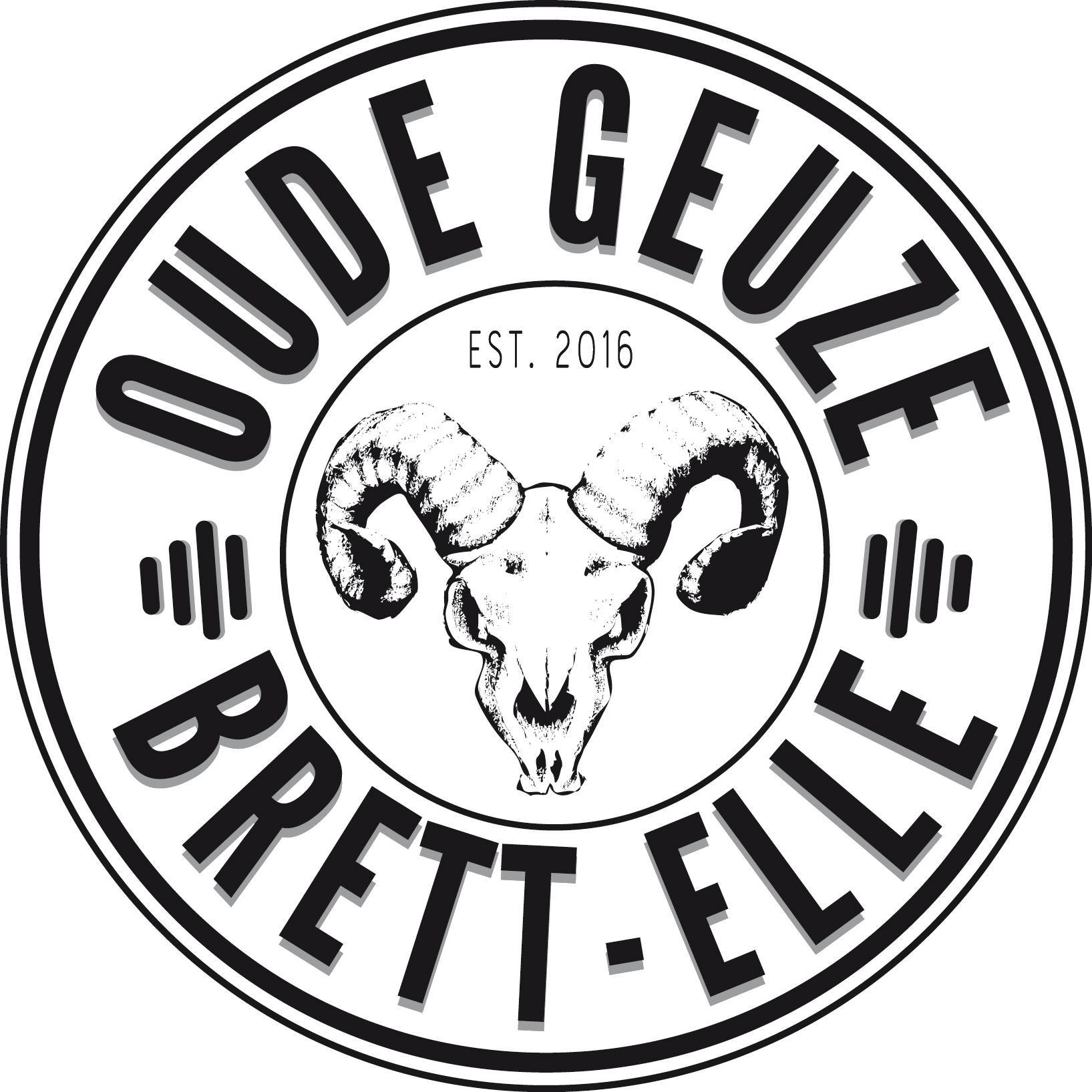
“The Beer Country” has not one, but two new lambic makers. I visited both during a recent trip in November-December. These lambic producers work together, so I will tell the story of both here. Lambiek Fabriek began when friends Jo Panneels (of Dworp), Jozef Van Bosstraeten (of Sint-Genesius-Rode), and Stijn Ecker (of Alsemberg) started buying lambics from various producers almost ten years ago, and blending it to make their own beers. Brouwerij Belgoo in Sint-Pieters-Leeuw is the other new lambic brewery.
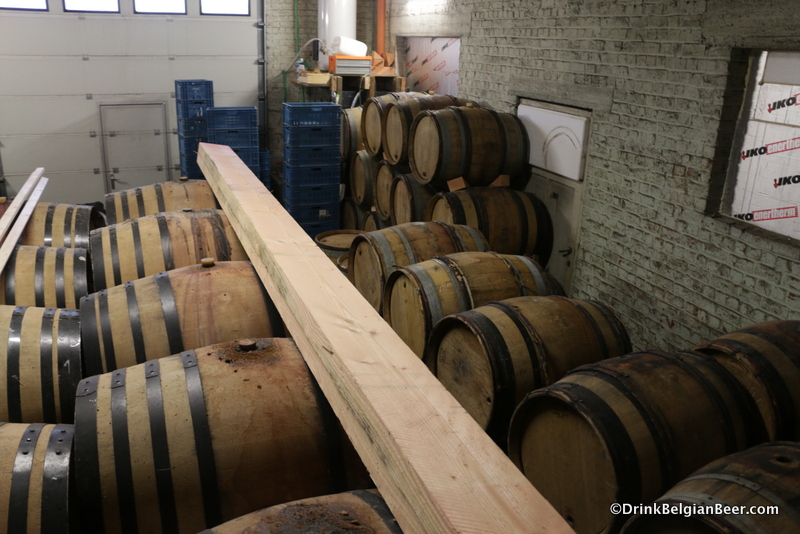
I’ll tell you more about all that below. What you may really want to know is: what can I seek out now, as a lambic drinker? “The first beer that we have offered for sale to the public is Brett-Elle Oude Geuze, and our lambic brewery is called Lambiek Fabriek. Brett-Elle is a blend of one and two year old lambics from our own coolship, and aged in our own barrels, as well as some nearly four year old lambic sourced from another lambic producer. Our geuze is refermented in the bottle, and aged for at least six months after bottling. It contains between 35 and 40% unmalted wheat. We came up with the name Lambiek Fabriek because the building we are located in is on Fabriekstraat in Ruisbroek,” said Jo Panneels, who I interviewed on a cold, rainy day at the end of November. Note that fabriek means factory, and Fabriekstraat means Factory Street.
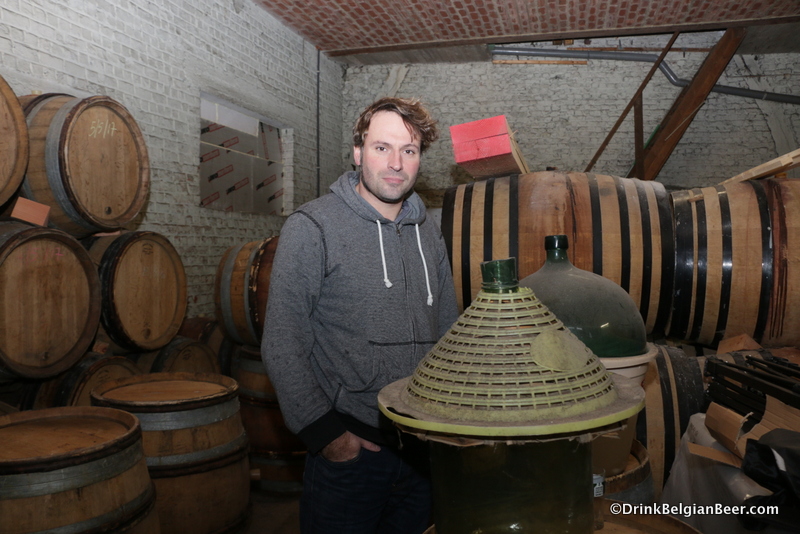

The name Brett-Elle refers to the wild brettanomyces yeasts that ferment lambic, and the fact that Jo, Jozef, and Stijn love women. Batch one debuted in late September 2017, and consisted of about 1,000 bottles in the 75 cl size, and 4,400 bottles of 37.5 cl. In batch 2, there are about 1,000 bottles of 75 cl and about 3,000 in 37.5 cl. “We think batch 3 will be ready sometime in summer 2018,” Panneels remarked. “So far, we have sold most of our production to specialty beer shops and beer-focused cafes, as well as restaurants. The beer shops include Schoentjes, De Koninck in Halle, Streekproductencentrum in Halle, and Bierhalle Deconinck in Vichte. Grill-Resto Boelekewis in Dworp and De Smidse in Alsemberg are two great restaurants where you can drink Brett-Elle. Also, the cafe In de Verzekering tegen de Grote Dorst in Eizeringen (Lennik) and the Les Brasseurs cafe in Brussels carry our geuze,” Panneels added.

About the brewing and blending of their lambics, Jozef Van Bosstraeten, who is the technical expert of the trio, had this to say: “From the moment the wort enters the ‘coolship’ the brewer loses control. However, it’s of primary importance to create the ideal conditions for lambic brewing and blending. It’s up to the wild yeasts and bacteria to determine how they do their job. This also applies to the barrels: giving each barrel the obligatory treatment, we all agree. But some barrels are lazy, even stubborn, and headstrong, which is frustrating. And there’s nothing you can do but accept that and be patient. Although a lazy barrel can act like a ‘bad ass’ and plague you for several years, it can miraculously transform into a very good friend, giving you refined, delicious lambiek!” He added: “Like mum always told me: “Don’t judge them too soon boy, give them a second chance!”
For the story of how Brett-Elle Oude Geuze came to be, we have to go back to the beginning, in 2008. Says Panneels: “We put the lambics that we bought from several producers, such as Boon, Girardin, Hanssens and Lindemans, into a demijohn (carboy), and added some locally sourced Schaarbeekse krieken (local sour cherries favored by lambic breweries and blenderies) to the lambics. We waited for six months, in which time the fruit macerated with the lambics, and then we bottled the blend. After that, we aged the bottles for six months. Then we opened a few, and we really liked the taste. Essentially our first experiment was an oude kriek: a blend of lambics of different ages, unsweetened, and macerated with sour cherries.”
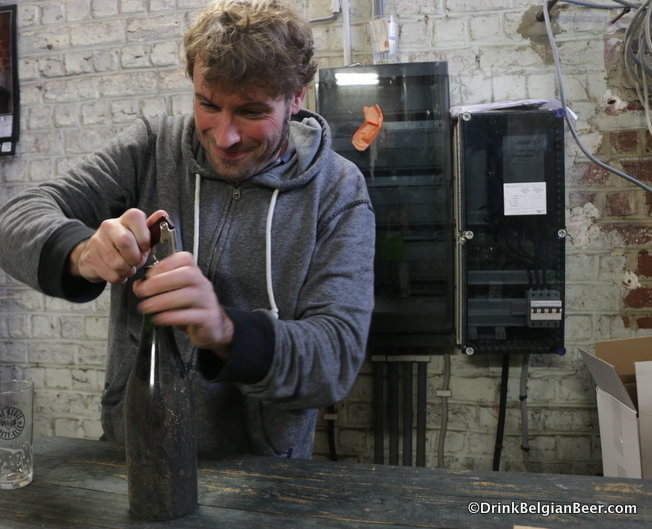
Panneels continued: “Not too long after that, we helped out with some grape harvests at a winery in France, Domaine de la Douaix. We knew the owner, Mark Moustie, as he lives in Dworp. Soon, we had access to some barrels. At first, though, it was just one cask, in the 200-liter size. However, even one barrel of oude kriek was way too much for the few of us to drink, even with many friends “helping” us. As everyone liked the quality of our oude kriek, we decided that we would start a lambic blendery some day.”
Jeroen Van Lier, owner of the superb De Smidse cafe/restaurant in Alsemberg, was also among the founding members of Lambiek Fabriek. However, business at “The Smithy” is so good that Jeroen had to stop with lambic blending to concentrate on his restaurant, which is a must visit for lambic lovers and anyone who likes to eat well. See this article in Celebrator Beer News for more information. Note that the Brett-Elle Oude Geuze is available at De Smidse.

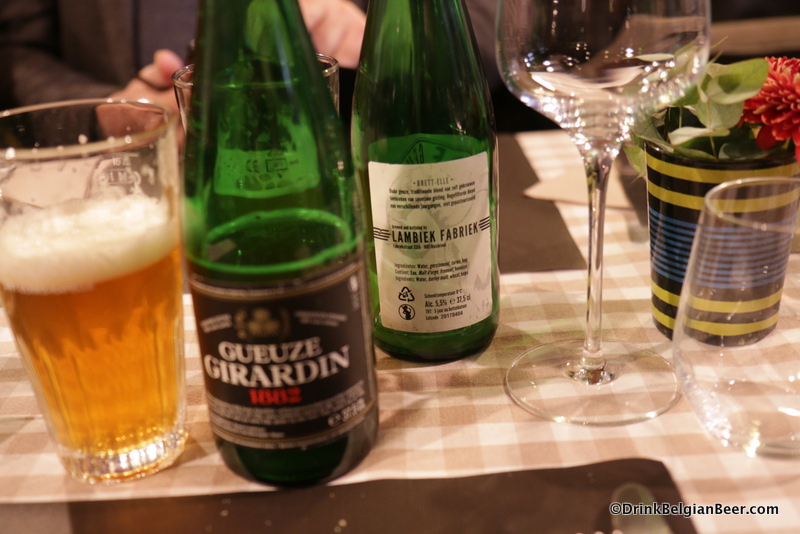
A few years passed before the group decided to try and make their dream a reality. When they did decide to go pro, they soon discovered that they had couple of big problems: one, lambic and geuze beers had grown exponentially in popularity since they started blending. This led to the price of lambic being increased considerably, which would make it more difficult for them to do business. Secondly, some of the bigger lambic breweries no longer wanted to sell lambic to new lambic producers. “At this point, we thought: we can either stop blending lambics, or find another solution,” Panneels remarked.

In the meantime, Jo Van Aert had opened his new Brouwerij Belgoo in the spring of 2015 in Sint-Pieters-Leeuw, located just 1.1 km (about 7/10 of a mile) from Brouwerij Belle-Vue, which in the past occasionally brewed beers such as the respected Belle-Vue Sélection Lambic. Van Aert had for many years had his highly-regarded Belgoo beers brewed at Brasserie La Binchoise in Wallonia, and he had wanted to open his own brewery for some time.
Belgoo’s location in the heart of Belgium’s lambic country led the members of Lambiek Fabriek to the conclusion that they could successfully brew lambic beers there. Van Aert was convinced as well, though he knew that he would have to take special care with the spontaneous fermentation, and the wild yeasts and other microflora that it attracts, so as not to infect Belgoo’s range of finely craft ales.
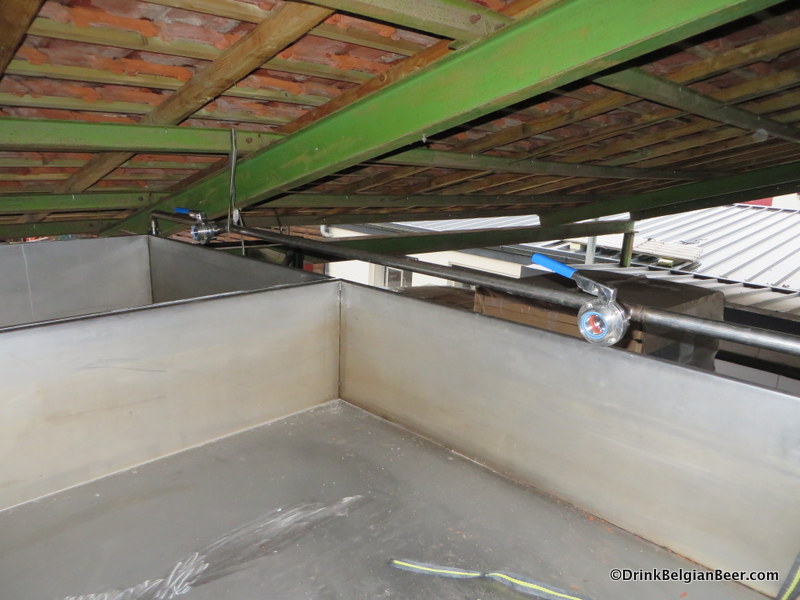
Panneels remarked: “So, we had found our solution. We would work closely with Brouwerij Belgoo. We had a stainless steel coolship built locally, and it was installed on the second floor (attic) at our location in Ruisbroek in the summer of 2015. The coolship was built in two parts, so as to be easier to move when necessary. We had to open a hole in the ceiling of our attic to get it up there. So we used this coolship for two winter brewing seasons, 2015-16 and 2016-17. But this arrangement was not ideal, as it had it own set of problems: we had to transport the hot wort about 4.5 km (2.8 miles) from Sint-Pieters-Leeuw to Ruisbroek and then get it to the coolship in the attic. So after two years, we consulted with Jo, and decided the best way to move forward would be to move the coolship to Belgoo. But in order to avoid wild yeasts, such as brettanomyces, infecting the normally fermented Belgoo beers, the coolship could not be installed inside the Belgoo brewery building.”
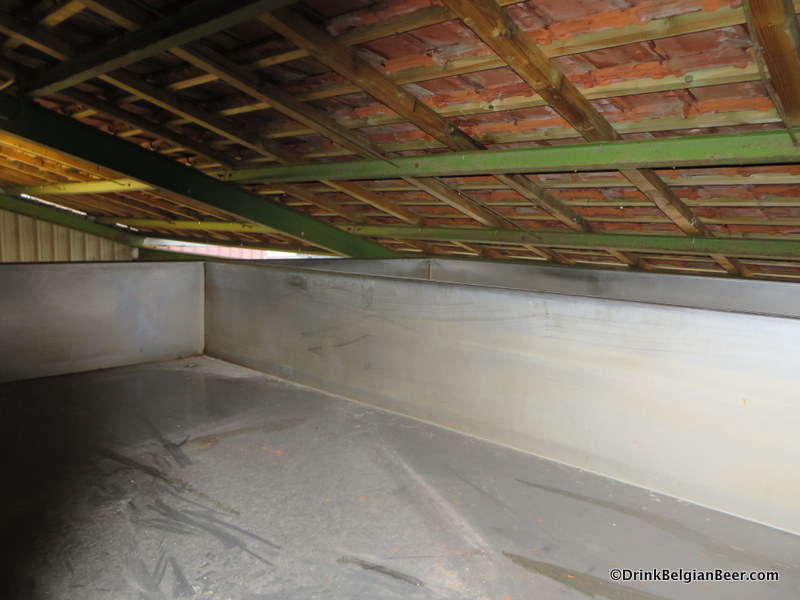

The coolship was moved to Belgoo in late October 2017, and was installed just outside a garage door leading into the brewery, 10 or 12 feet in the air. A roof was constructed first so the coolship would be covered. The coolship is open to the air on its sides, with mesh wire around it so nothing large can fall into it, but so the cold night air and lambic-producing yeasts and bacteria can get in and inoculate the wort after a brew day. “We also constructed a pipeline to run from the brewing installation to the coolship, so the hot wort can be pumped there directly. Now, all we have to do is pump the cooled wort into plastic containers the morning after a brew day, transport them to Ruisbroek, and put it into our own barrels,” Panneels said.
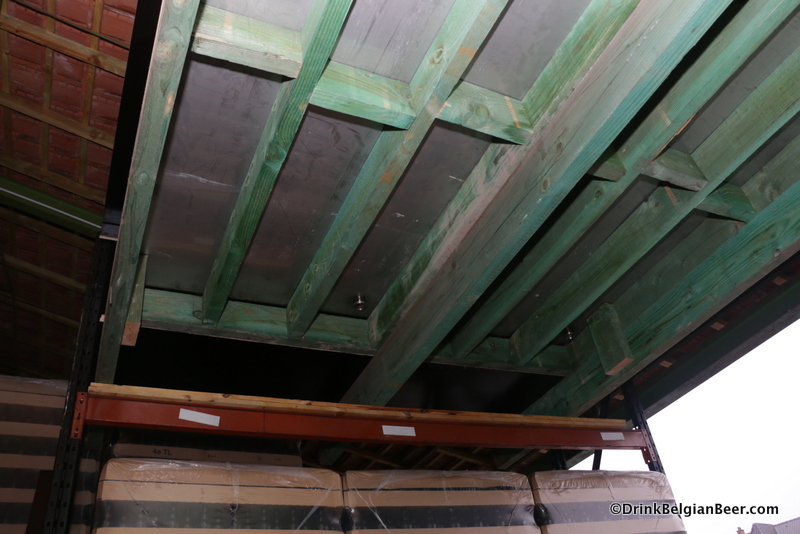
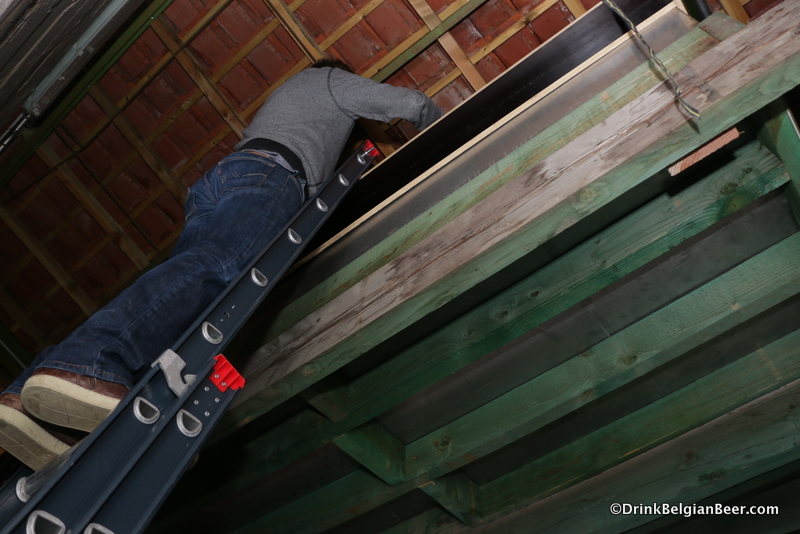
The Belgoo/Lambiek Fabriek coolship can hold about 2400 liters, which is 24 hectoliters (about 20.5 U.S. barrels) of wort. The coolship was purposely fabricated to this size, as Belgoo’s Italian-built brewery has a batch size of about 24 hectoliters, so one batch will completely fill the coolship.
As to its barrel room, Lambiek Fabriek had about forty casks in the 400-liter (3.4 barrel) size, and 35 more containing 220 liters each, during my visit. In late December, Panneels told me that 40 more barrels in the 400-liter size had just arrived from France: “We have already emptied many barrels to produce our first batch of Brett-Elle. With the barrels we just received, we now have enough empty casks to fill with the wort from about 15 brew days during the 2017-2018 season.”

I tasted a ten month old lambic right from a 400-liter barrel during my visit to Lambiek Fabriek in Ruisbroek, and I found it to be much like many lambics I have tasted at other lambic breweries and blenderies in Belgium’s lambic country. It was mildly tart, refreshing, and with little sweetness and mild funk, and still in its maturation phase.
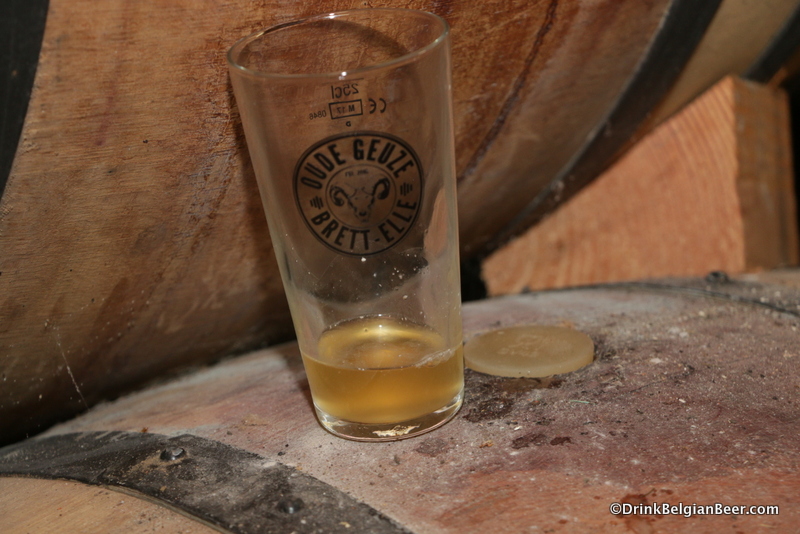
We then tasted the Brett-Elle Oude Geuze, which, though still fairly young, impressed me as having a lot of potential. It had a noticeable funky aroma from the brettanomyces yeasts, a citrusy character, with green apples evident, and a pleasing, mild to medium tartness. I think a couple of years of bottle aging will round it out into a very interesting and more complex geuze. Panneels then opened another treat: a 75 cl bottle of oude kriek that the partners had bottled in 2010.
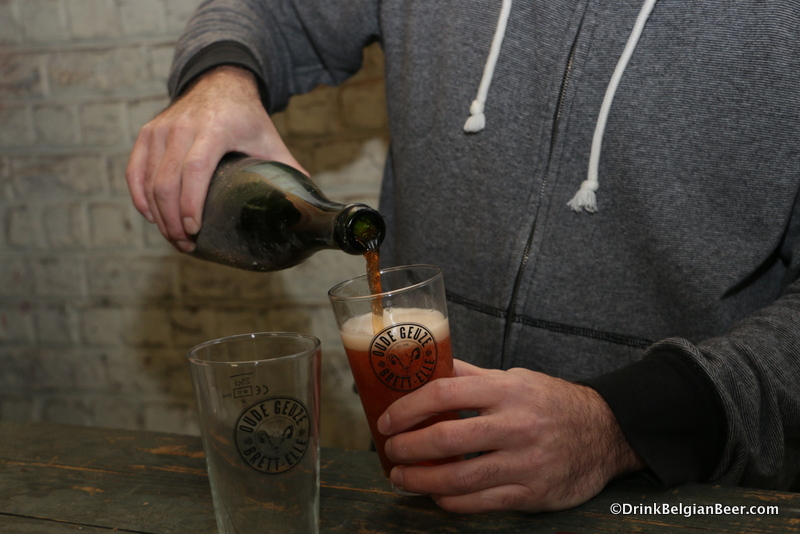
“This one was made with lambics from Girardin, Lindemans, and Boon. It’s one of a couple of diffferent oude kriek blends we bottled that year. It’s maybe a little too tart for me, but I hope you will like it,” Panneels remarked. Like it I did. I would say it had just a bit more than a medium tartness, with noticeable funk, fruit character and with a moderate complexity. A pretty well done kriek, it was. Enough so that I brought another 2010 bottle home, from a different blend.

As to the possibility of future beers, Panneels added: “The aim now is to concentrate on our Brett-Elle. But in the future, we will probably do some fruit beers. Producing an oude kriek would be a natural for us.”
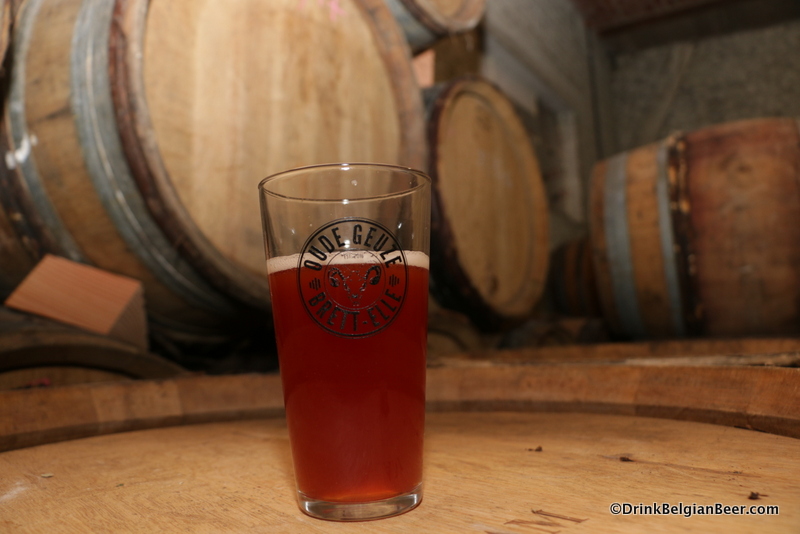
Panneels then remarked: “You are the first American to visit Lambiek Fabriek. We have had a lot of requests for visits, but as you can see, the building is not so big, and not really well set up for tours at the moment. In fact, if things go well, we may outgrow this building within 2 or 3 years.”
That’s an exciting start, eh? Allow me to add some context and history, and it will make even more sense that the three partners were a natural to start a new lambic brewery.
During our drive from Brussels to Lambiek Fabriek’s location in Ruisbroek, Jo filled me in on some of his family history. “My grandmother ran a pub in Dworp, and she served Winderickx lambic and geuze. I was born and raised with geuze and kriek and lambic beers all around me. I have spent all my life living here in the Payottenland and Zenne Valley.”
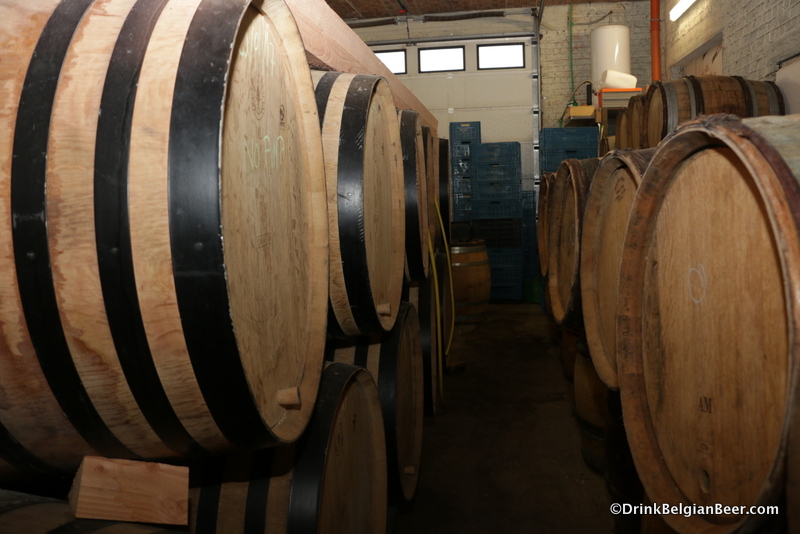
The same can be said of Jo’s partners, who are all from the area. “This building was probably built in the 1950’s, and it belonged to Jeroen’s mother when we started using it a little over three years ago. In fact, Jeroen’s grandfather used to be a beer distributor, working in this same location, and he even blended some lambic from Brouwerij De Troch (of Wambeek) to make his own geuze for a few years,” Panneels remarked.
Lambiek Fabriek’s location in Ruisbroek is only 2.2 kilometers (1.37 miles) north of 3 Fonteinen’s new lambik-O-droom site in Lot. Both are in the heart of Belgium’s lambic country. Without doubt, the microclimate, and accompanying brettanomyces yeasts and bacteria, must be similar.
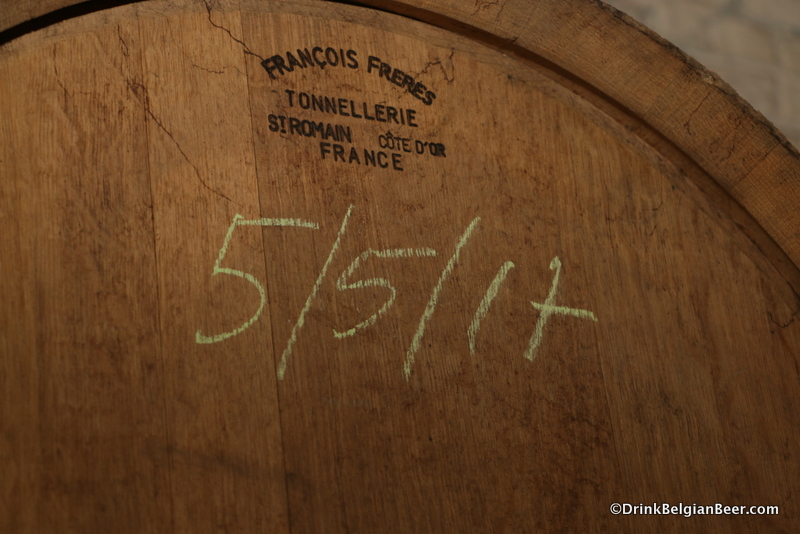
I wrote above that there are two new lambic producers in Belgium, so let’s continue. Brouwerij Belgoo started brewing its own lambics, to a different recipe than Lambiek Fabriek’s, in early 2017. “Let’s tour the brewery,” said Jo Van Aert, during my second stop on that cold rainy day. “Classic Belgian winter weather, eh?” Panneels remarked. Meaning: great for cozy pub visits, but not too good for outside photography.
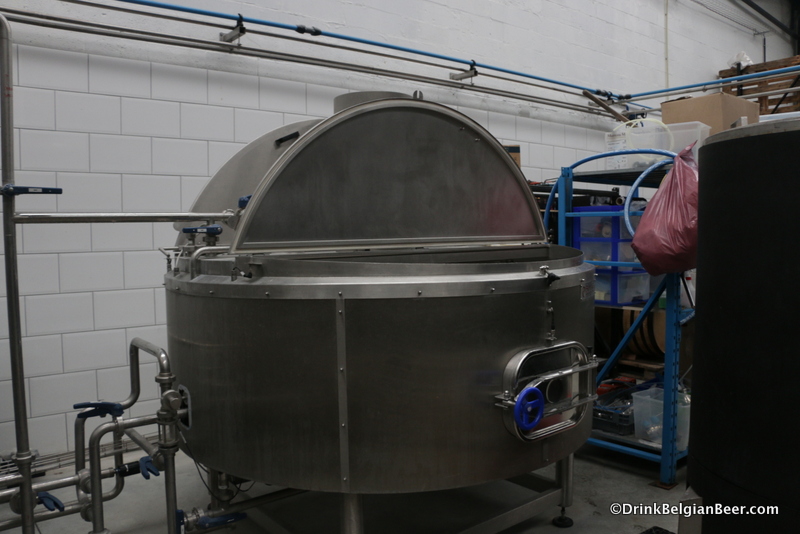
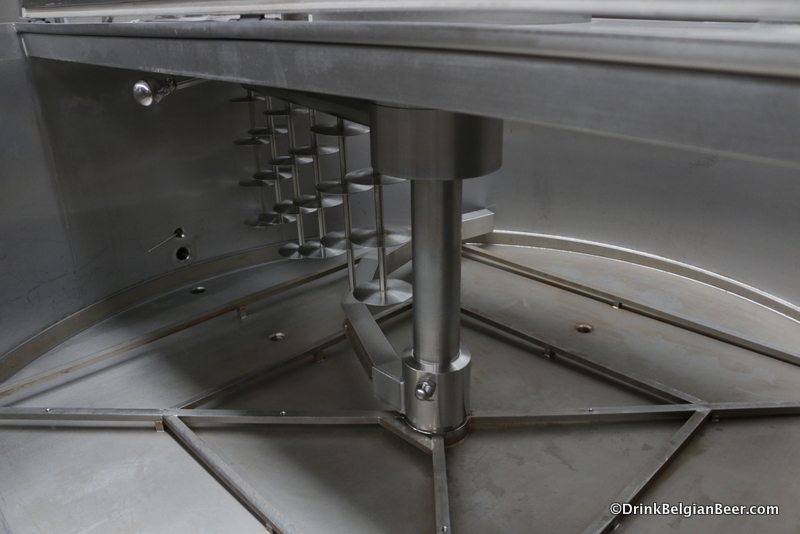
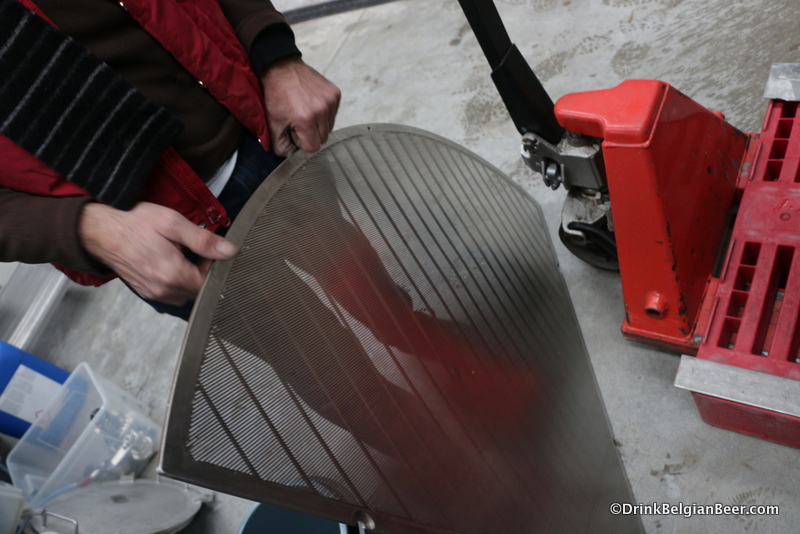
This was my second visit to Belgoo; I had first visited in the spring of 2015, not long after Van Aert had opened his new brewery. As we toured the facility, he remarked: “The boiling kettle was made in Italy, and the mash tun was made in Belgium. I can put a lot of wheat in it, which is of course necessary for brewing lambic beers. I also use some wheat in my Belgoo Saisonneke, Saisonneke Extra, and Saisonneke Bio. Wheat gives these beers a fuller bodied taste due to the extra proteins.”

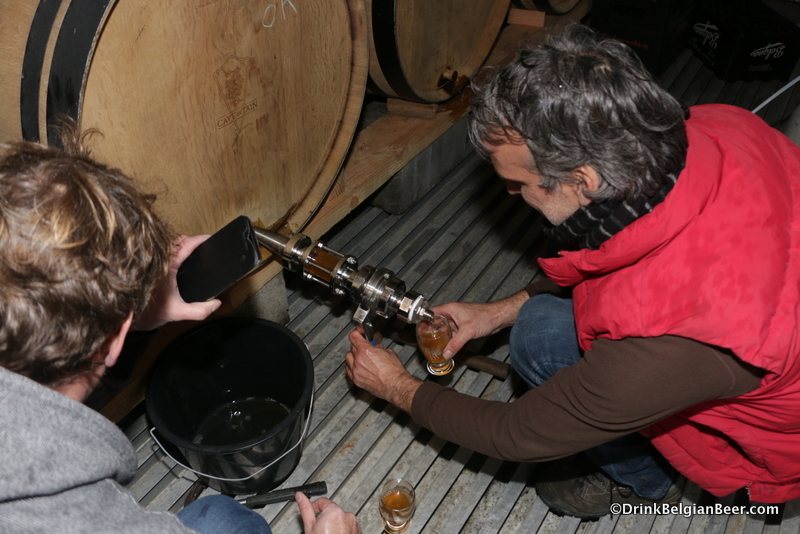
As we walked outside the brewery, Van Aert remarked: “As you can see, I don’t have a barrel room for maturing lambic inside the brewery, due to the risk of contamination of my normally fermented beers. So my temporary solution is the two trailers that you see here in the parking lot.” He added: “These trailers are freezers, so I can quite easily, and with a relatively low amount of energy use, regulate the temperature inside them to that which is ideal for the fermentation and maturation of lambic. At present, I have about 20 barrels in each trailer, in the 400-liter size. Let’s taste one!”

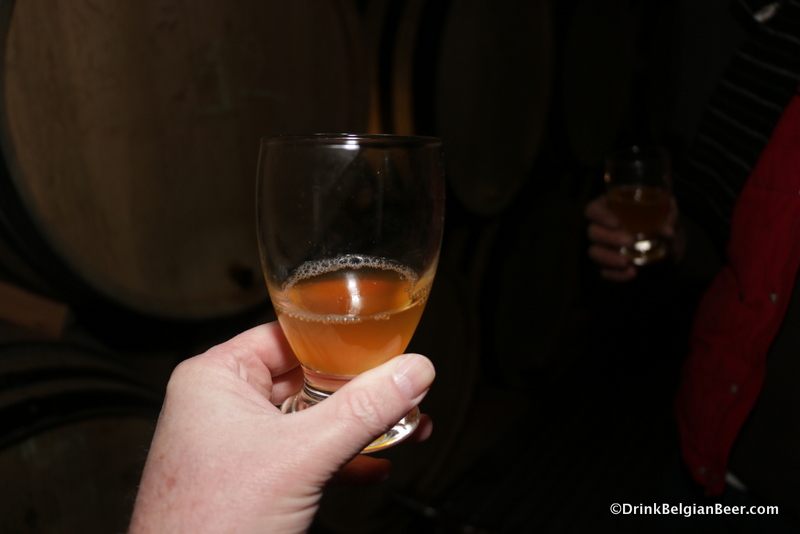
I quickly agreed to this suggestion. Van Aert and Panneels then set about tapping into a barrel. As there was no artificial lighting inside the freezer, Panneels held a light while I photographed Van Aert tapping into the cask.
“This barrel was filled in early March 2017, so the lambic is about 8 months old,” Van Aert remarked, as we tasted a sample. We all agreed it had evident notes of green apple and a classic young lambic taste. It was refreshing, with a medium dryness, and was starting to develop some funky notes, just as a young lambic should. “The lambic in each barrel has its own taste, and its own evolution. Some taste more dry, some taste more fruity,” Panneels remarked.
“I have another lambic with some fruits added in the other trailer. Let’s go have a taste,” Van Aert suggested. It was an easy sale. “I added some krieken to this lambic, as well as red currants, and it has about nine or ten months on barrel,” he remarked.


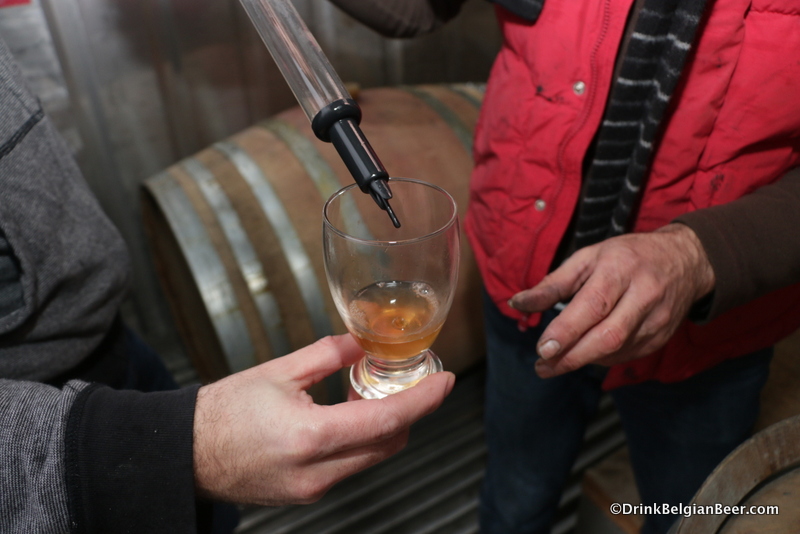
This lambic had a very interesting fruit character, with a pleasing level of tartness and moderate funk. “This is one to taste again in about six months. I think it’s going to be a good one,” Van Aert commented, as Panneels and I agreed.

We then returned to the brewery and to its cozy tasting room, yards from the lambics. I had also looked forward to tasting Belgoo’s excellent Saisonneke again, which is a saison of session strength, at 4.4% abv, with lots of character. Van Aert commented: “We are going to taste the new Saisonneke Bio first. This one is made completely with organically made ingredients. It has exactly the same recipe as the normal Saisonneke, but with a different hop. This is because one of the hops in the normal Saisonneke is not available as bio/organically grown.”
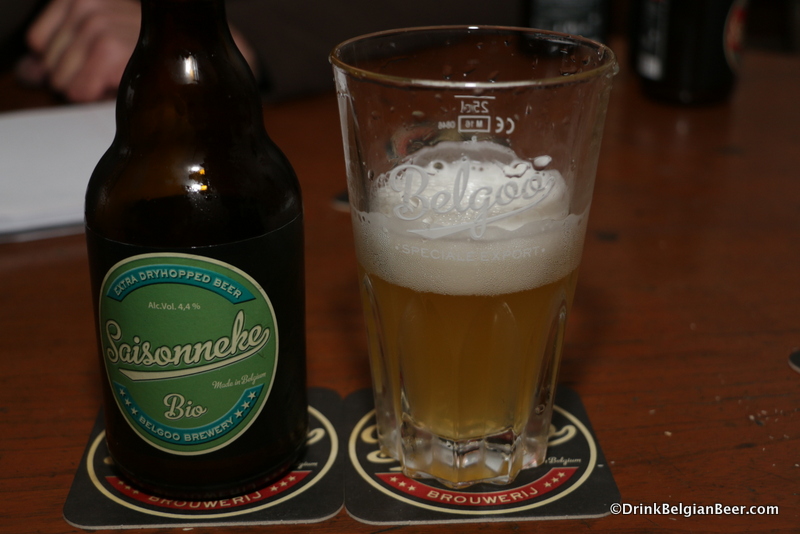
The Saisonneke Bio has a very well balanced malt, wheat, and hop character, with easy drinkability, and about 40 ibu’s (International Bittering Units.) “The Bio is very cloudy, whereas the normal Saisonneke is almost clear. Bio beers are almost always cloudy, and this does not dissipate much even as the beer’s temperature changes,” Van Aert remarked.
Next up, we tasted Saisonneke Extra, which is dry-hopped with one of my all time favorites, Nelson Sauvin. This hop has a wine-like character and is a great hop for using with saisons, in my opinion. “The taste is very good, but it is an expensive hop. It costs 40 UK pounds (Note: $53.50 at today’s exchange rate) per kilo (2.2 pounds) so that is about 400 U.K. pounds just for dry-hopping one batch of the Extra,” Van Aert remarked. He added: “This one is best after one month in the bottle. After six months, it is past its prime.”
We also tasted the Belgoo Blond Bio, a beer made with three different grains: barley, wheat, and spelt. This interesting blond is unfiltered, unpasteurized, and refermented in 33 cl bottles. There are no spices or chemical additives in the beer. It makes for an easy drinking, medium bodied brew with 6.4% abv.
At this point, it was towards the end of the day, so our tasting session was over.

As to their plans for the tasting room at Belgoo, Van Aert and Panneels stated they plan to bring some used barrels into the room soon to add some more ambiance. The tasting room is already decorated with a number of old, local breweriana pieces, such as enamel plates. There is also old antique furniture, and a wooden bar. It is a fine spot to sample great beers. “Maybe in the future, we will have a joint opening day every month, where people can come and taste both the Belgoo beers and the Lambiek Fabriek brews in the same place,” Panneels remarked. “The aim to to create a small pub in the future,” he added.
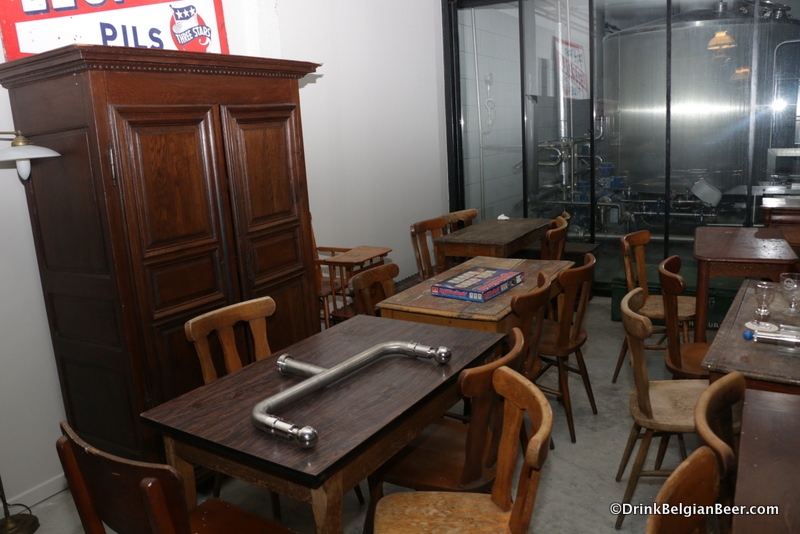
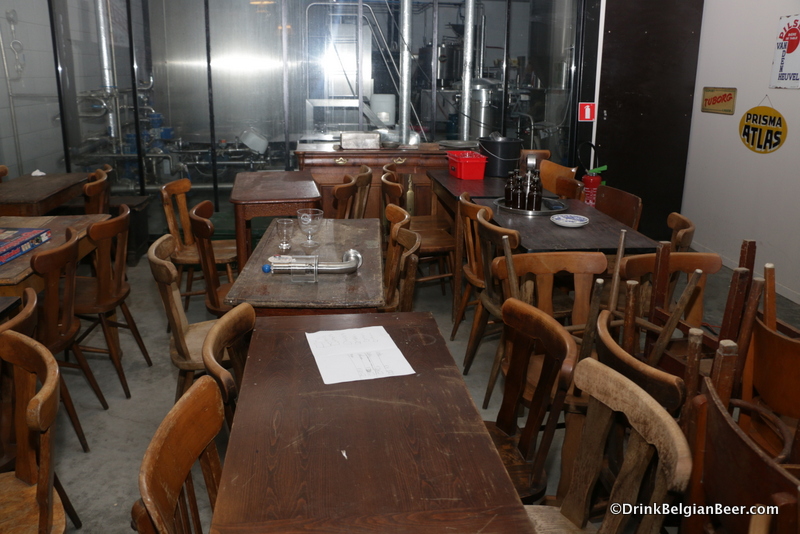
When that does happen, public transport may be an option, although it will take a little motivation. “If you are coming from Brussels, you can take the metro to the Eddy Merckx stop on the number 5 (yellow) line, and then take a bus that will stop near here,” Panneels advised.
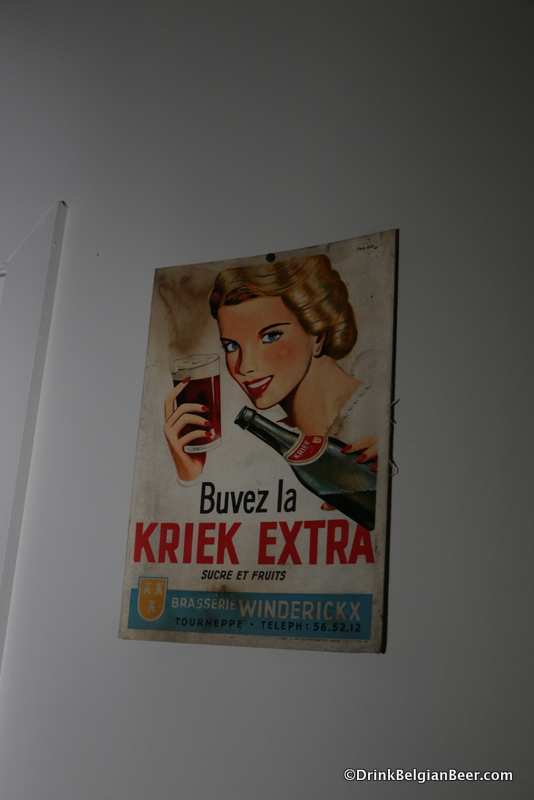
Lambiek Fabriek and Belgoo are two interesting and promising new lambic producers, run by friendly, knowledgeable, enthusiastic beer lovers. I highly recommend seeking their beers out. Don’t forget Belgoo’s normal range of beers either. Neither places are open for tours at this point in time.

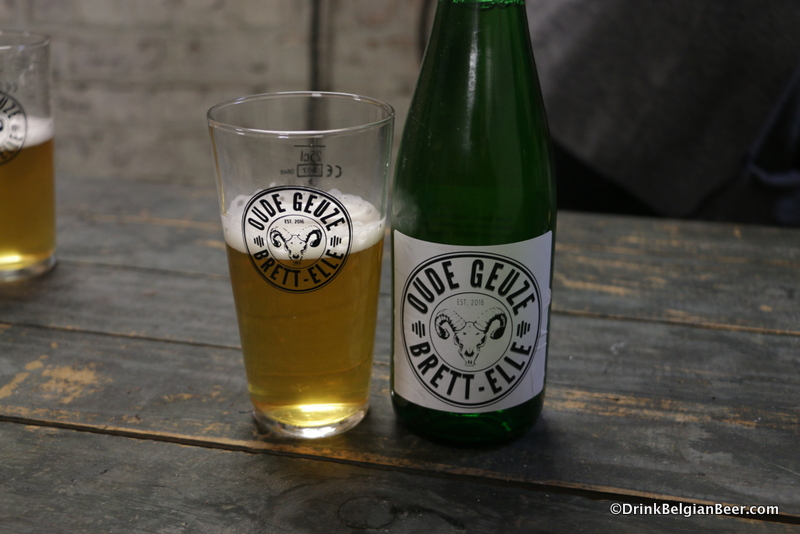
Leave a Reply